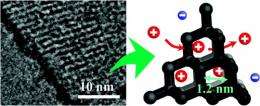January 26, 2011 feature
High-performance capacitor could lead to better rechargeable batteries

(PhysOrg.com) -- In order to develop next-generation electric vehicles, solar energy systems, and other clean energy technologies, researchers need an efficient way to store the energy. One of the key energy storage devices for these applications and others is a supercapacitor, also called an electric double-layer capacitor. In a recent study, scientists have investigated the possibility of using a material called zeolite-templated carbon for the electrode in this type of capacitor, and found that the material’s unique pore structure greatly improves the capacitor's overall performance.
The researchers, Hiroyuki Itoi, Hirotomo Nishihara, Taichi Kogure, and Takashi Kyotani, from Tohoku University in Sendai, Japan, have published their results on the high-performance electric double-layer capacitor in a recent issue of the Journal of the American Chemical Society.
To store energy, the electric double-layer capacitor is charged by ions that migrate from a bulk solution to an electrode, where they are adsorbed. Before reaching the electrode’s surface, the ions have to travel through narrow nanopores as quickly and efficiently as possible. Basically, the quicker the ions can travel down these paths, the quicker the capacitor can be charged, resulting in a high rate performance. Also, the greater the adsorbed ion density in the electrode, the greater the charge that the capacitor can store, resulting in a high volumetric capacitance.
Recently, scientists have been testing materials with pores of various sizes and structures to try to achieve both quick ion transport and high adsorption ion density. But the two requirements are somewhat contradictory, since ions can travel more quickly through larger nanopores, but large nanopores make the electrode density low and thus decrease the adsorbed ion density.
“In this work, we have successfully demonstrated that it is possible to meet the two seemingly contradictory requirements, high power density and high volumetric capacitance, with zeolite-templated carbon,” Nishihara told PhysOrg.com.
The zeolite-templated carbon consists of nanopores that are 1.2 nm in diameter (smaller than most electrode materials) and that have a very ordered structure (whereas other pores can be disordered and random). The nanopores’ small size makes the adsorbed ion density high, while the ordered structure – described as a diamond-like framework – allows the ions to quickly pass through the nanopores. In a previous study, the researchers showed that zeolite-templated carbon with nanopores smaller than 1.2 nm cannot enable fast ion transport, suggesting that this size may provide the optimal balance between high rate performance and high volumetric capacitance.
In tests, the zeolite-templated carbon’s properties exceeded those of other materials, demonstrating its potential to be used as an electrode for high-performance electric double-layer capacitors.
“We are now trying to further increase the energy density of the zeolite-templated carbon up to the same level of secondary batteries,” Nishihara said. “If such an electric double layer capacitor is developed and used for mobile devices, such as cellular phones, their charging time can be shortened to only a few minutes. Another important future application of electric double layer capacitors is a support of secondary batteries in electric vehicles to prolong the battery's lifetime. Also for this purpose, achieving a higher energy density is one of the key issues.”
More information: Hiroyuki Itoi, et al. “Three-Dimensionally Arrayed and Mutually Connected 1.2-nm Nanopores for High-Performance Electric Double Layer Capacitor.” Journal of the American Chemical Society. DOI:10.1021/ja108315p
Copyright 2010 PhysOrg.com.
All rights reserved. This material may not be published, broadcast, rewritten or redistributed in whole or part without the express written permission of PhysOrg.com.















